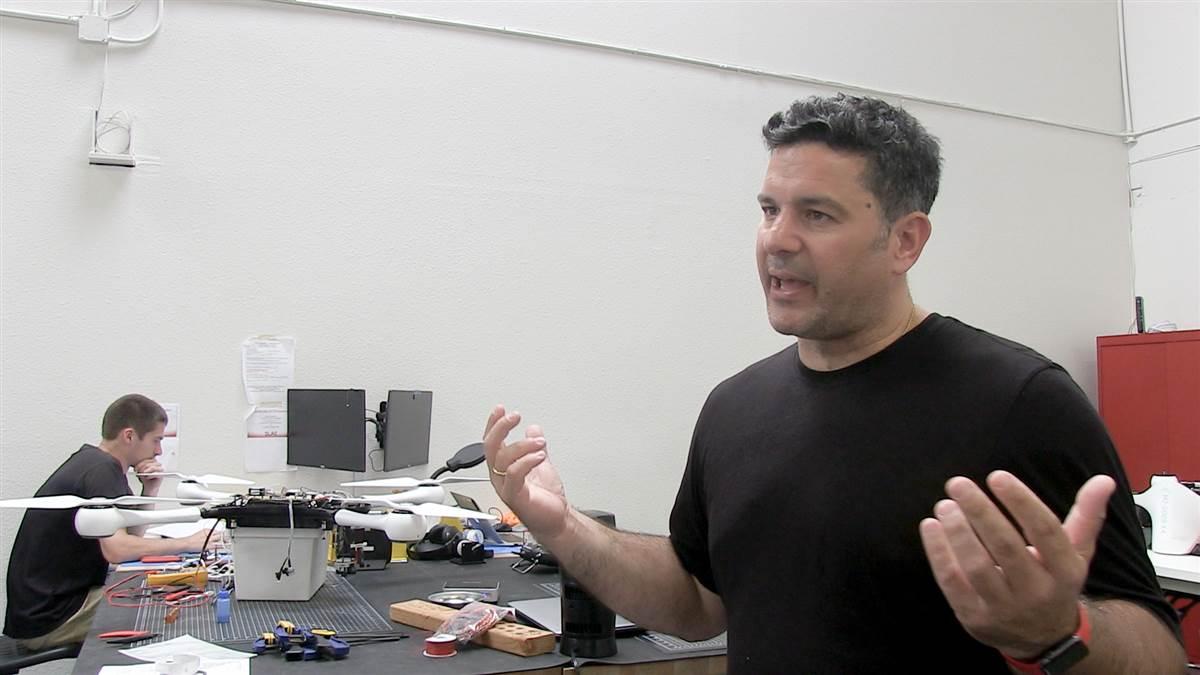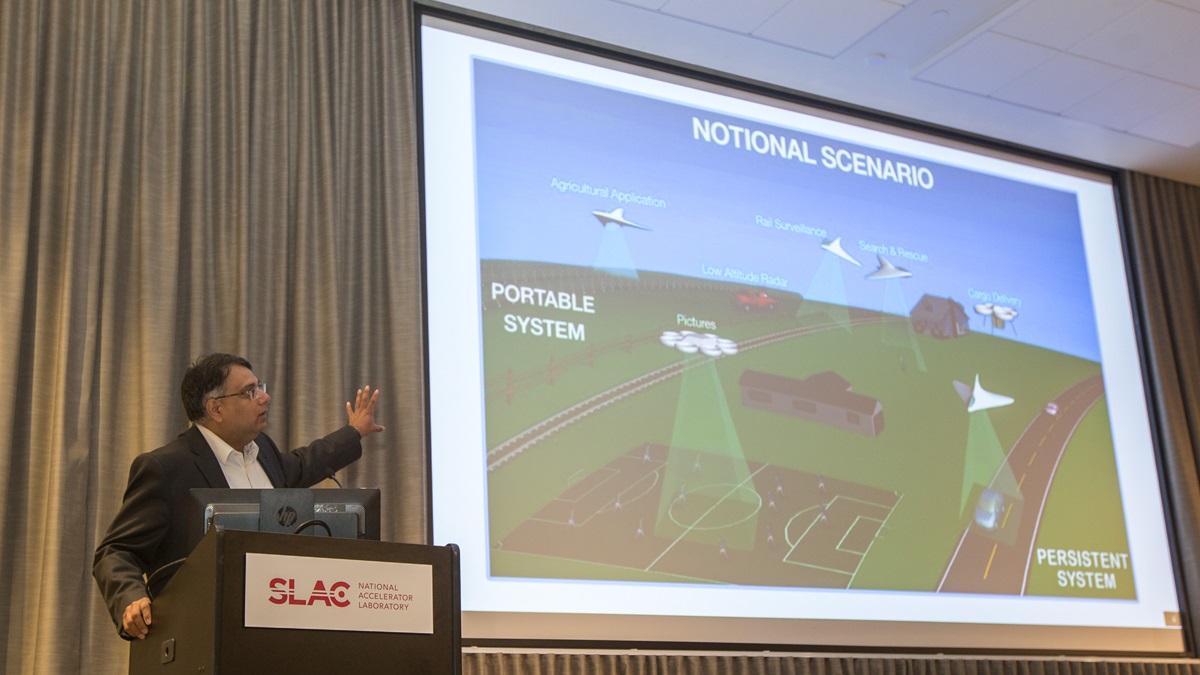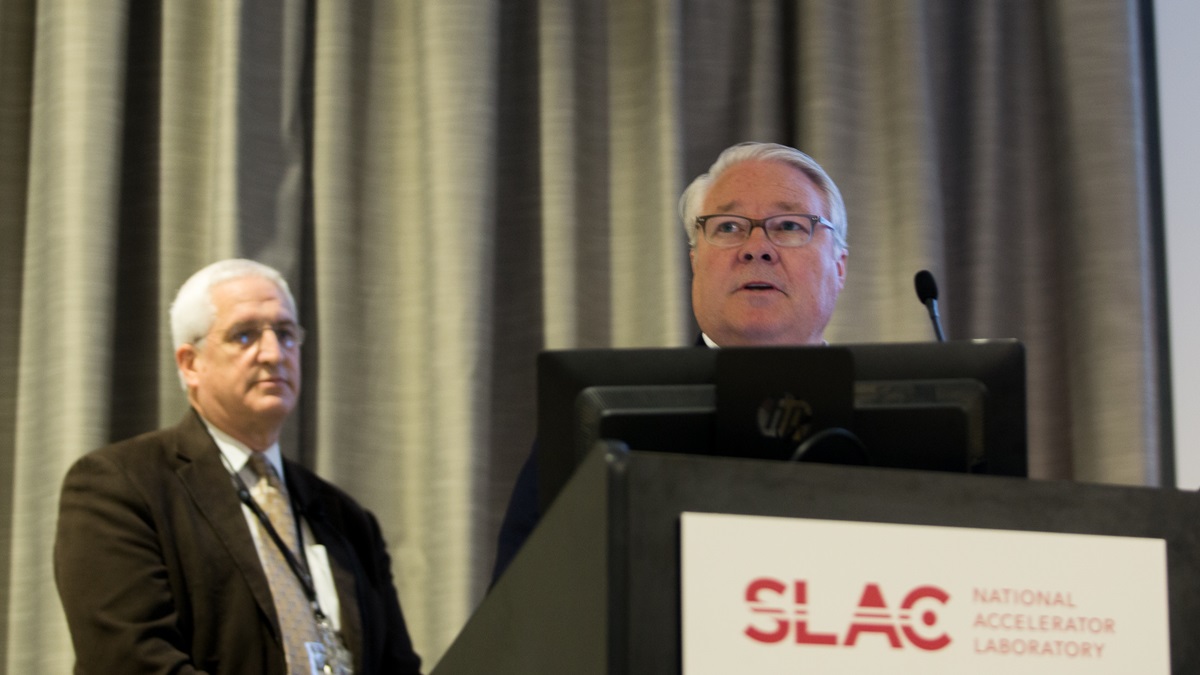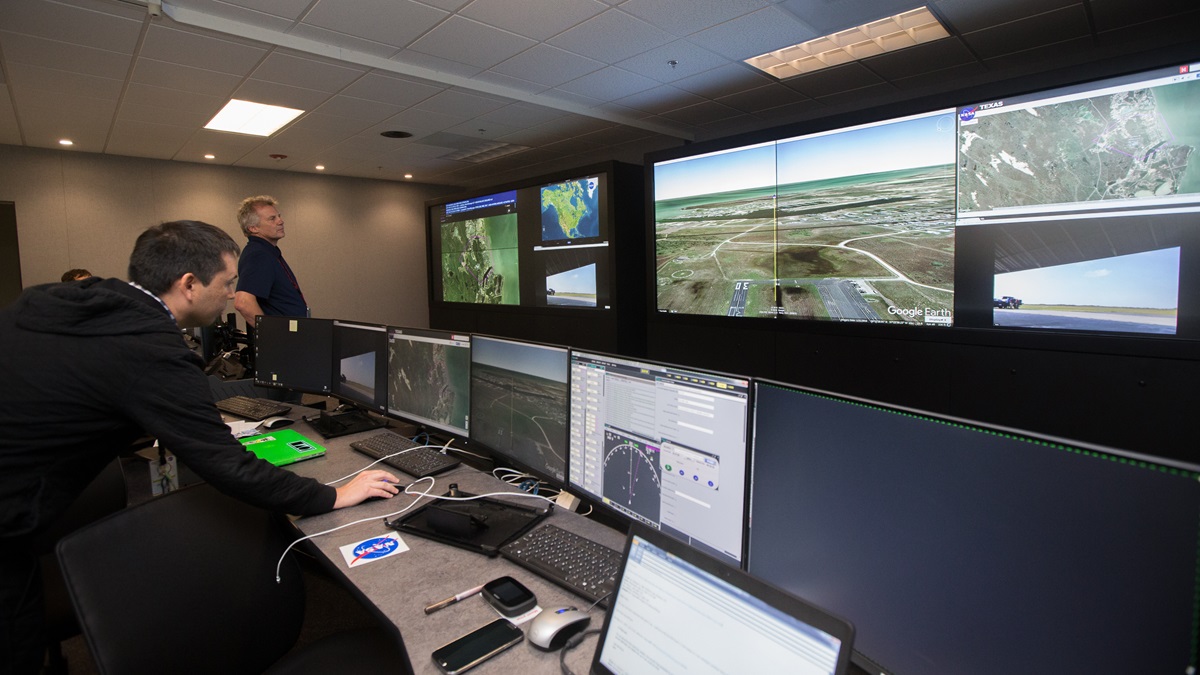Striving for flight beyond sight
Silicon Valley firms, firefighters collaborate
Firefighters from around California, along with search-and-rescue specialists from across the country, joined drone developers, regulators, and researchers for a symposium on drones for emergency response June 2 in the heart of Silicon Valley. Many have an eye on making drones more useful by freeing them from the limits of human vision.
The Menlo Park Fire Protection District covers Menlo Park, California, and surrounding towns including the portion of Palo Alto where Stanford University’s SLAC National Accelerator Laboratory has turned out groundbreaking research and Nobel prizes since 1962. That laboratory, one of 10 U.S. Department of Energy Office of Science laboratories around the country, is both part of the area of responsibility for Menlo Park’s firefighters, and the facility that hosted the department’s June 2 symposium on unmanned aircraft for firefighting.
About 200 uniformed personnel from fire departments and emergency management agencies across California and beyond (including representatives of federal urban search and rescue task forces around the country, of which Menlo Park is one), spent the day listening to presentations, watching demonstrations, and learning the fine points of developing a drone capability. Menlo Park’s own drone program was developed over several years, as AOPA previously reported, and the fire district’s leaders hope to help others follow their lead.
Also among the attendees and presenters were FAA officials and NASA scientists, including Mark Micirie, who was among the pioneers in ground rescue robotics dating to the 1990s. Micirie offered a cautionary tale about the perils of technology development clashing with regulations, and marveled at the response to Menlo Park’s invitation as he gazed at the crowd in the SLAC auditorium.
“We never in the ground robotics world had this kind of response, with this many uniforms sitting, trying to figure out how to incorporate this type of equipment into the way that they do business,” Micirie said.
‘A mobility crisis’
The confluence of a culture of innovation, brain power, and some of the most congested roads in the country help explain why Menlo Park developed a drone capability that has become a six-figure line item, according to the fire chief, made possible by the wealth of a community with more than its share of wealthy entrepreneurs. That budget supports a large and diverse fleet of unmanned aircraft, ranging from small quadcopters used to search and observe, to larger systems including a hexacopter that can lift thermal and visual cameras.
The fire protection district has also inked a non-monetary, cooperative technology development agreement with Matternet, the local firm now field testing in Switzerland a quadcopter that carries a red plastic payload box that can carry medicines, lab samples, and other medical deliveries between hospitals. While cameras are the current payload of choice (having no other useful options), Fire Chief Harold Schapelhouman held one of the red Matternet boxes aloft (customized with Menlo Park Fire Protection District logos) to help explain the vision.
“This is where I think drone technology will go next for us,” Schapelhouman said. “A drone that can carry multiple packages that benefit us. So, our expense goes down because … we have one vehicle that can do a lot of different things.”
Meanwhile, cameras have many uses as a primary fire rescue payload of today, the chief said, recalling one of his own experiences from early in his career (which now spans 36 years as a firefighter and one of the nation's leading rescue experts). As a young firefighter, Schapelhouman was tasked to head to the roof of a burning strip mall and cut ventilation holes, a task interrupted by the unexpected (and very unusual) arrival of the fire chief at the top of the ladder. After a few moments of observation, the chief pulled his men off the roof.
“It was a little frustrating for me because I was the one cutting a lot of the holes, and so I didn't get to finish what we were starting, and I'm thinking, ‘why is the chief doing this?’ Well, a few minutes later I got my reason, and that's when the roof went in,” Schapelhouman said. “And, you know, whether we would have been off it or not, I don't know.”
Schapelhouman said the knowledge, skills and ability of trained firefighters will never be replaced by drones, “but today, we can use the technology we're talking about here to look before we even maybe get up on top of the roof, or maybe know what we're dealing with, with a thermal camera attached to a drone.”
Peter Carpenter, whose own history includes work in advanced military research, service as a smoke jumper, and as an AOPA member and pilot, is the president of the fire district’s board, and offered another rationale for why Menlo Park is going all-in on firefighting drones, both present and future.
“Short term, what we have is a mobility crisis. Our general response is relatively large pieces of equipment trying to go down crowded if not totally blocked roads, and that model is literally grinding to a halt,” Carpenter said. The vision for future firefighting missions includes dispatching a drone, perhaps one made by Matternet, to fly ahead of the fire engines and rescue trucks and give responders a first look at the scene, allowing faster decisions to be made to scale a response up or down, perhaps trimming crucial minutes from the time needed to assemble the required resources.
Carpenter cited another reason why Menlo Park is a natural epicenter for developing firefighting drones: “Living in the culture that we live in here, we have the liberty to say to the people that we work with, 'Go ahead and try something that hasn't been done before. Go ahead and take risks. And if it doesn't work out, don't worry, we're not going to fire you, we just want to know what you learned from your failure.'”
Segregation vs. cooperation
A few miles away from SLAC, Matternet CEO Andreas Raptopoulos welcomed AOPA to tour the compact company headquarters housed in space that resembles oversized garages in a local technology park, one side set up as an office with staff working on laptops around a large conference table, and the other half of the space a manufacturing lab where the M2 quadcopters are built, tested, and maintained. The interview began by cell phone, as Raptopoulos was stuck in heavy traffic, and continued with a tour of the facility.

Founded in 2011, Matternet has undertaken much the same mission as Amazon is also pursuing, to revolutionize logistics and delivery using drones flown BVLOS by pilots who program a route in advance and launch the system with a few taps on an iPhone. Real-world tests were first conducted in developing countries, where aviation regulators were more cooperative, and air traffic was much mores sparse, and also where the road infrastructure creates its own flavor of mobility crisis.
After proving the concept in places like New Guinea and Malawi, Matternet has spent the last three years in Switzerland, where aviation authorities and Swiss Post have welcomed the drone maker. In March, Matternet claimed the distinction of being the first in the world to be authorized to conduct drone deliveries beyond line of sight over populated areas, specifically the Swiss community of Lugano, home to about 50,000 residents.
Matternet drones are flown at low altitudes, 400 feet and below, generally, along predefined routes connecting two points, hospitals, in the case of Switzerland. Each M2 drone can carry a payload box weighing about 4 pounds, and flights are coordinated with a private Swiss provider of air traffic control services. As the M2 flies the route, which is developed in advance based on factors including terrain, and avoidance of the most densely crowded areas where people may congregate outdoors, it beams about 100 points of telemetry data each second through the cellular network to the ground crew through a cloud-based, central system. A parachute is primed to deploy if the system detects a failure or anomaly that could bring the drone down, to ensure it will hit the ground with less force than would be lethal to a human, Raptopoulos said.
He hopes that similar operations will be conducted in U.S. airspace, and said the company is still evaluating whether such tests could be conducted under Part 107 with appropriate waivers. The question of safe integration is key to unlocking the potential of drones to deliver not only life-saving supplies, but also shoes and other consumer goods, drastically reducing the cost of last-mile deliveries, often cited as the most expensive link in the logistics chain.
To achieve that, federal regulators must decide, for one thing, whether drones will be integrated in a cooperative model, sharing airspace with manned aircraft, or segregated by altitude or other defined areas of operation. On this point, Raptopoulos has a clear view: cooperation will be much more efficient, and “is probably my preference.”
“Currently, in Switzerland, we are working on scaling up these types of deployments,” Raptopoulos said, adding that Matternet is weeks away from scaling up to missions over a much larger city, close to a major international airport. And more than once in a long conversation, he mentioned the potential to serve Stanford Hospital in much the same way, if and when regulations allow.
“If I have a request for a delivery at Stanford Hospital, then our system automatically generates a route that connects those two locations. And we take a number of things into account, of course airspace. We fly exclusively in Class G airspace for now, so we avoid all other classes of airspace,” Raptopoulos said, adding that BVLOS operations in the United States will probably take the approach, starting, as NASA has done, with its unmanned traffic management tests over sparsely populated areas.
Integration of drones, he said, may follow a similar path to the development and integration of autonomous vehicles now being tested in Pittsburgh and elsewhere.
“The logic has to be, current users are able to use” the airspace, Raptopoulos said. “I think there are ways we can operate.”
Centralized control and electronic tracking of drones in flight, with a cloud-based system for distributing the information to all airspace users, are key ingredients of the Matternet model, but on-board detect-and-avoid capability is not. Raptopoulos said the M2 system's situational awareness comes from the centralized traffic management, though the aircraft itself cannot detect other aircraft during flight.
“Having said that, the work that is happening in sensors is really sort of developing very rapidly right now. We are looking at that problem of basically detect and avoid mostly for ground obstacles,” Raptopoulos said. “So you know, as we're thinking about delivery and we're thinking about the last component of the last mile, it's very important that you're able to reflect, to react in a safe manner to a dynamically sort of animated environment on the ground.”
Preventing collision with manned aircraft will probably have some form of detect-and-avoid component, he added, though not necessarily built into the drone.
“I think there's some very interesting work that is happening to help basically deconflict airspace as well, so if you have a noncooperative agent in the airspace that you're utilizing, how can you sense and avoid that entity as well,” Raptopoulos said. By “noncooperative agent,” he meant, for example, a vintage Piper Cub that lacks radios.
‘You are riding a wave’
As Matternet and Menlo Park collaborate on what future fire drones might look like, what payloads they carry, and where, the symposium also featured more than one word of caution, both in terms of skeptics who wondered aloud if the time is right to jump in with both feet, and another take from Micirie, who recounted his own experience building ground robots for disaster response, then not building them.
Today, he focuses on space-based robotics, having been in the private sector when the rescue robots first deployed after the Sept. 11, 2001, attacks on the World Trade Center in New York and subsequently refined, were brought to a grinding halt. A 2006 memo from the federal government ruled there would be no federal funding for, or approval of, the purchase of disaster response robots until safety standards had been developed and approved. The market, and enthusiasm, dried up literally overnight.
“There was no one to sell to,” Micirie recalled. “We ended up selling to New Jersey Task Force One, which is a state team, and basically a couple of departments overseas that didn't see it the same way.”
Micirie acknowledged that was a somewhat discordant note, coming near the end of a day spent studying and learning about exciting new drone technology.
“My point here is to move quickly, that you are riding a wave right now and it is very, very important for this momentum to keep going,” Micirie said. “I strongly suggest doing that, and keeping that momentum going.”













